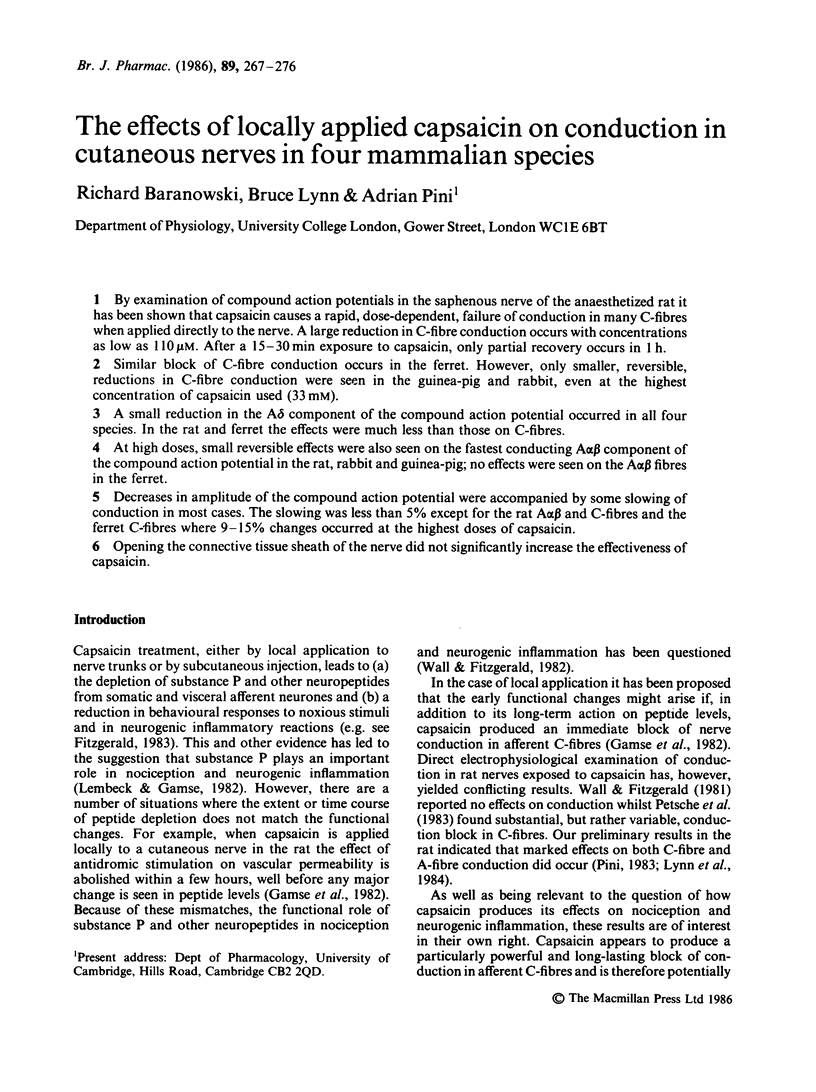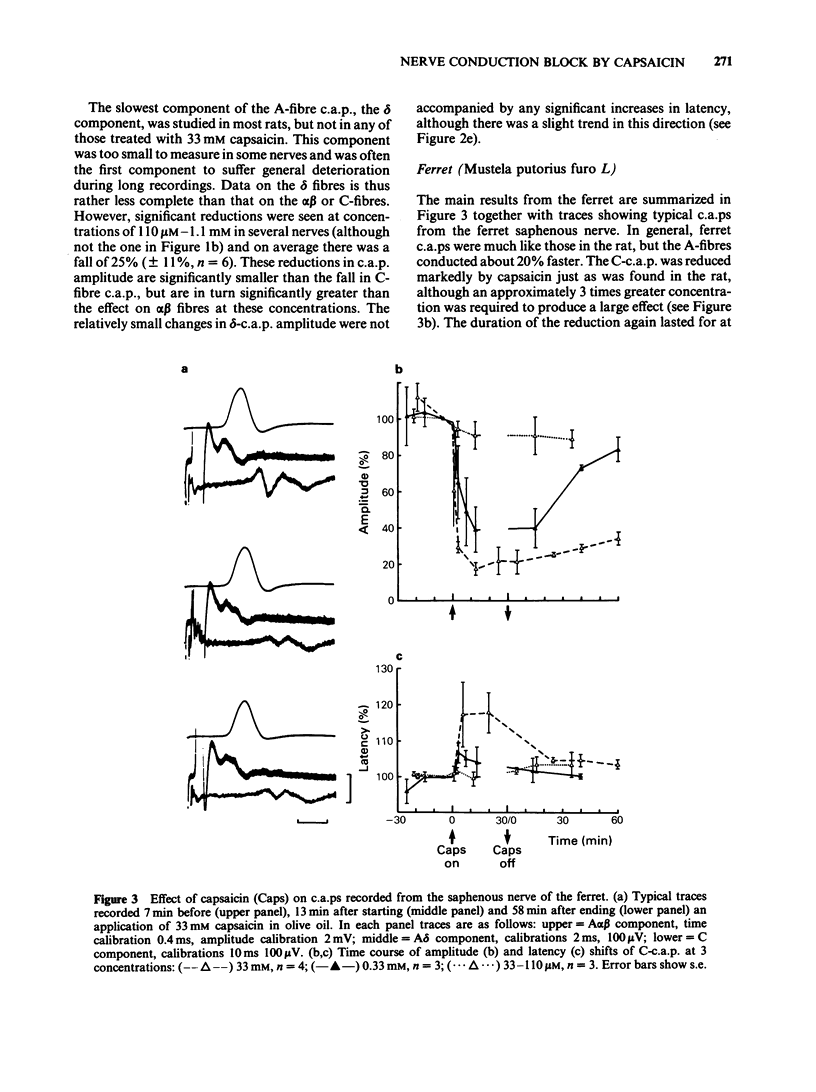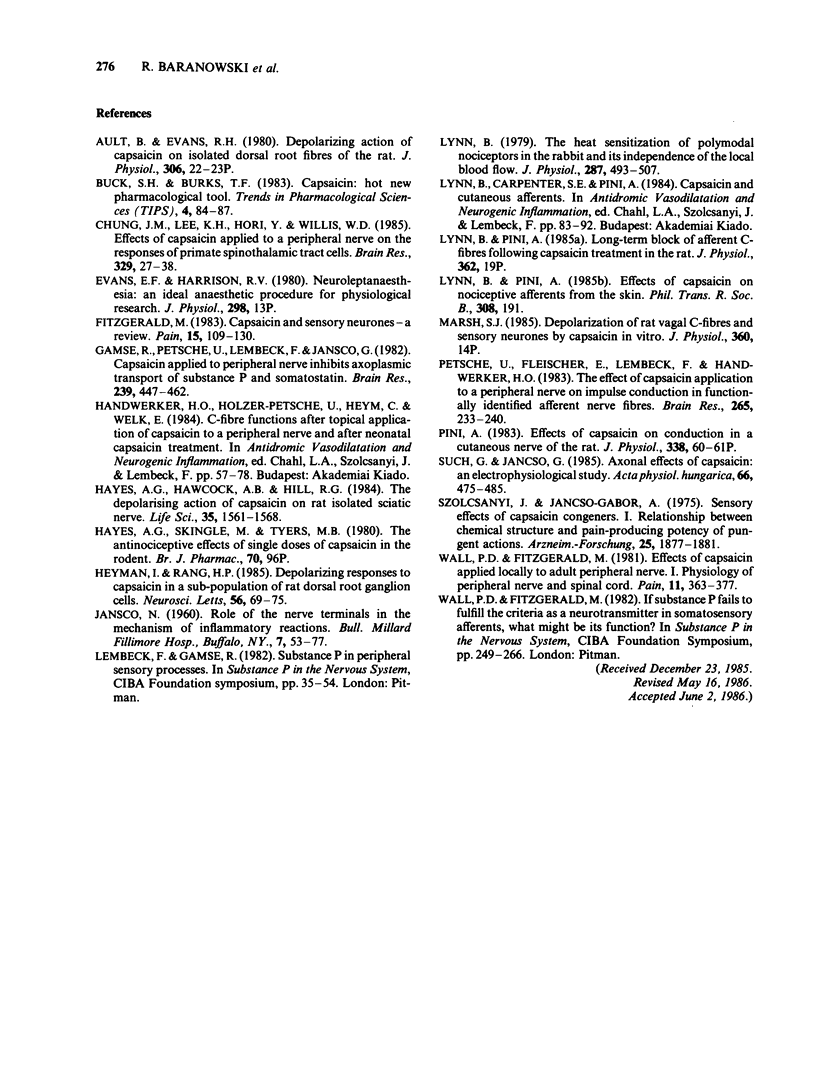Abstract
By examination of compound action potentials in the saphenous nerve of the anaesthetized rat it has been shown that capsaicin causes a rapid, dose-dependent, failure of conduction in many C-fibres when applied directly to the nerve. A large reduction in C-fibre conduction occurs with concentrations as low as 110 microM. After a 15-30 min exposure to capsaicin, only partial recovery occurs in 1 h. Similar block of C-fibre conduction occurs in the ferret. However, only smaller, reversible, reductions in C-fibre conduction were seen in the guinea-pig and rabbit, even at the highest concentration of capsaicin used (33 mM). A small reduction in the A delta component of the compound action potential occurred in all four species. In the rat and ferret the effects were much less than those on C-fibres. At high doses, small reversible effects were also seen on the fastest conducting A alpha beta component of the compound action potential in the rat, rabbit and guinea-pig; no effects were seen on the A alpha beta fibres in the ferret. Decreases in amplitude of the compound action potential were accompanied by some slowing of conduction in most cases. The slowing was less than 5% except for the rat A alpha beta and C-fibres and the ferret C-fibres where 9-15% changes occurred at the highest doses of capsaicin. Opening the connective tissue sheath of the nerve did not significantly increase the effectiveness of capsaicin.
Full text
PDF









Selected References
These references are in PubMed. This may not be the complete list of references from this article.
- Chung J. M., Lee K. H., Hori Y., Willis W. D. Effects of capsaicin applied to a peripheral nerve on the responses of primate spinothalamic tract cells. Brain Res. 1985 Mar 11;329(1-2):27–38. doi: 10.1016/0006-8993(85)90509-8. [DOI] [PubMed] [Google Scholar]
- Evans E. F., Harrison R. V. Neuroleptanaesthesia: an ideal anaesthetic procedure for physiological studies on the guniea-pig [proceedings]. J Physiol. 1980 Jan;298:13P–14P. [PubMed] [Google Scholar]
- Fitzgerald M. Capsaicin and sensory neurones--a review. Pain. 1983 Feb;15(2):109–130. doi: 10.1016/0304-3959(83)90012-x. [DOI] [PubMed] [Google Scholar]
- Gamse R., Petsche U., Lembeck F., Jancsò G. Capsaicin applied to peripheral nerve inhibits axoplasmic transport of substance P and somatostatin. Brain Res. 1982 May 13;239(2):447–462. doi: 10.1016/0006-8993(82)90521-2. [DOI] [PubMed] [Google Scholar]
- Hayes A. G., Hawcock A. B., Hill R. G. The depolarising action of capsaicin on rat isolated sciatic nerve. Life Sci. 1984 Oct 8;35(15):1561–1568. doi: 10.1016/0024-3205(84)90354-0. [DOI] [PubMed] [Google Scholar]
- Heyman I., Rang H. P. Depolarizing responses to capsaicin in a subpopulation of rat dorsal root ganglion cells. Neurosci Lett. 1985 May 1;56(1):69–75. doi: 10.1016/0304-3940(85)90442-2. [DOI] [PubMed] [Google Scholar]
- Lembeck F., Gamse R. Substance P in peripheral sensory processes. Ciba Found Symp. 1982;(91):35–54. doi: 10.1002/9780470720738.ch4. [DOI] [PubMed] [Google Scholar]
- Lynn B. The heat sensitization of polymodal nociceptors in the rabbit and its independence of the local blood flow. J Physiol. 1979 Feb;287:493–507. doi: 10.1113/jphysiol.1979.sp012672. [DOI] [PMC free article] [PubMed] [Google Scholar]
- Petsche U., Fleischer E., Lembeck F., Handwerker H. O. The effect of capsaicin application to a peripheral nerve on impulse conduction in functionally identified afferent nerve fibres. Brain Res. 1983 Apr 18;265(2):233–240. doi: 10.1016/0006-8993(83)90337-2. [DOI] [PubMed] [Google Scholar]
- Szolcsányi J., Jancsó-Gábor A. Sensory effects of capsaicin congeners I. Relationship between chemical structure and pain-producing potency of pungent agents. Arzneimittelforschung. 1975;25(12):1877–1881. [PubMed] [Google Scholar]
- Wall P. D., Fitzgerald M. Effects of capsaicin applied locally to adult peripheral nerve. I. Physiology of peripheral nerve and spinal cord. Pain. 1981 Dec;11(3):363–377. doi: 10.1016/0304-3959(81)90636-9. [DOI] [PubMed] [Google Scholar]
- Wall P. D., Fitzgerald M. If substance P fails to fulfil the criteria as a neurotransmitter in somatosensory afferents, what might be its function? Ciba Found Symp. 1982;(91):249–266. doi: 10.1002/9780470720738.ch14. [DOI] [PubMed] [Google Scholar]


